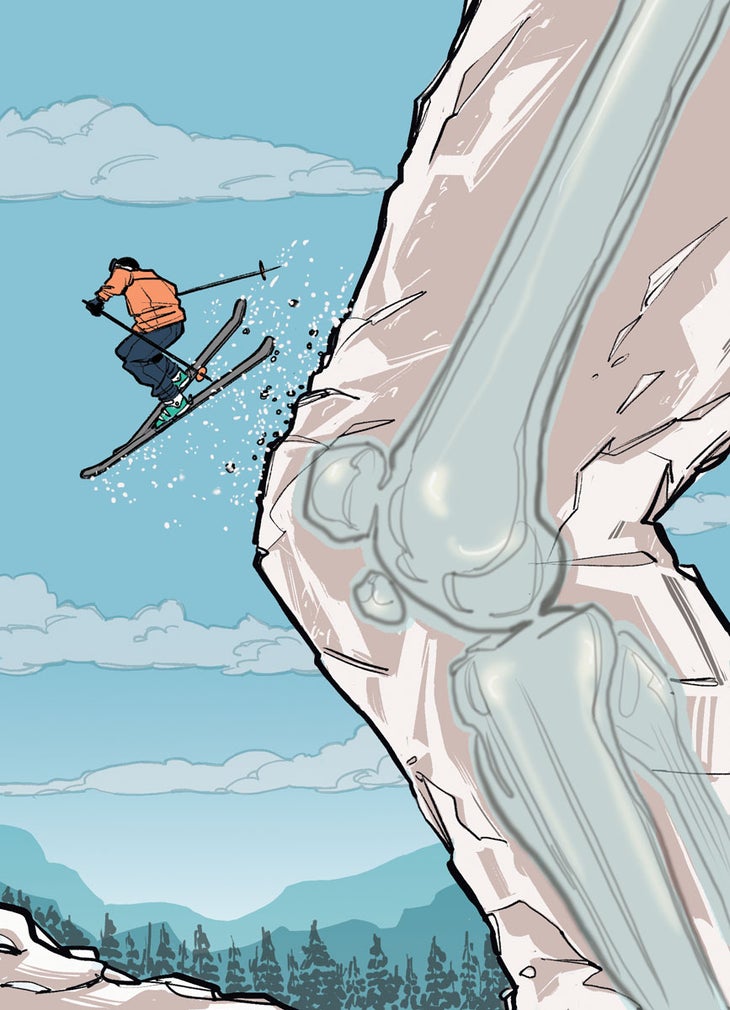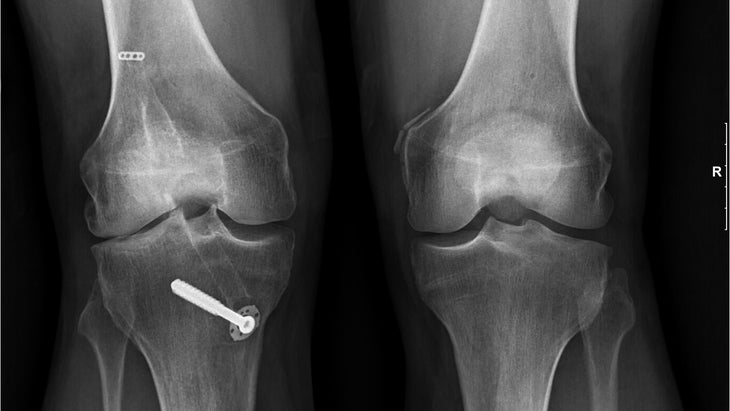Seattle Stem Cell Repair of Torn Meniscus
Get access to everything we publish when you sign up for Outside+.
For near two decades, Tim Petrick skied with constant pain in his right knee. As the former President and CEO of K2 Sports and the current COO at Silverton Mountain in Colorado, he's had the fortune to ski some of the world's most majestic mountains, and has probably made several million, mostly satisfying, turns.
But in 2000, one of a skier's worst fears struck while Petrick was heli skiing in Alaska. "I tumbled down a couloir following (the late) Doug Coombs in deep powder and blew my ACL out," says Petrick. "I also lost parts of my medial and lateral meniscus from going end over end." After surgery to repair his ACL, his knee deteriorated over the next decade and he was prescribed an unloader knee brace, which mitigated the pain just enough so he could ski. "I wore that brace religiously because if I didn't wear it, my knee would ache like crazy," he says.

Petrick knew he was a classic candidate for total knee replacement surgery, but that seemed like a daunting decision to him. After years of being a hard-charging athlete, it also felt a bit like a defeat, a surrender of sorts on the battlefield of your body.
His doctor, Mark D. Wagner, MD, of Seattle Sports & Regenerative Medicine, recommended an alternative to the invasive joint replacement surgery. Wagner, an avid skier himself, had recently begun performing a procedure called Stem Cell Therapy. The procedure uses the patient's own stem cells mixed with a sample of bone marrow and adipose tissue, which is spun in a centrifuge and injected into the damaged joint in what Wagner likens to spackle filling in the cracks. "You can also think of the stem cells as seeds you put on the bare spots on your lawn," says Wagner. "Your platelets are the fertilizer, promoting growth. The stem cells sense the environment, go into the joint, and lay down new cartilage."
The payback many skiers face after years of carving turns down icy slopes or the repetitive pounding from moguls is the breaking down of cartilage in their joints, particularly the knees. Cartilage is the tissue found on all joint surfaces, but because it's not supplied with blood vessels, it doesn't self-repair. Stem cells are found throughout the body and have the potential to become any type of cell—including those found in cartilage. They can help the body regenerate tissue by implanting cells that stimulate healing and reduce the painful effects of osteoarthritis. "Our results with Stem Cell Therapy are impressive," says Wagner. "About 85 percent of patients have significantly improved within one year."
Adult stem cell treatments have been used successfully for years to treat diseases such as leukemia and related blood and bone cancers. Unlike embryonic stem cells, the use of adult stem cells does not carry the same shadow of controversy because it doesn't involve the fate of an embryo.
Stem Cell Therapy, however, has a negative side. As a relatively new procedure in the U.S.—doctors in Europe were performing the procedure over a decade ago, first using mammalian stem cells—long-term patient outcomes haven't been thoroughly studied.
It can also be cost-prohibitive. "Currently there are no FDA-approved stem cell treatments for knee injuries or osteoarthritis," says Andrea Fischer, Press Officer for the U.S. Food and Drug Administration. Since the FDA does not sanction Stem Cell Therapy, insurance companies do not offer coverage. Even though the therapy involves about a 90-minute outpatient procedure performed under local anesthesia, the out-of-pocket expense can range between $5,000 and $12,000.

At this time, it's unclear whether Stem Cell Therapy will eventually be considered for government approval, and therefore coverage. According to the FDA, however, potential safety concerns include a reaction at the injection site, an unwanted immune response to the cells, failure of the cells to function as anticipated, and even the development of tumors. Currently the FDA only approves stem cell products derived from cord blood that's used for treating blood disorders, and warns about potentially unsafe stem cell practices. "It's imperative that individuals considering stem cell therapy be informed of the risks and consumers are encouraged to contact the FDA to learn more," Fischer says.
After weighing the pros and cons, the 63-year-old life-long skier opted for Stem Cell Therapy in September 2016. "I took a chance," Petrick says. "It's an experimental procedure and insurance doesn't cover it, but I'd do it tomorrow versus thinking about having a replacement knee." The procedure did involve blood, bone marrow, and fat tissue withdrawal, but Petrick isn't squeamish about needles. As the doctor injected the cocktail of his own stem cells and platelet-rich plasma into Petrick's knee, there was discomfort from the pressure, but it went away in a few hours.
After a few weeks of limited activity, Petrick started riding his bike. After four months—which coincided with the start of last ski season—the knee that ached for nearly 16 years started to feel normal again.
Now one year after the procedure, Petrick's knee is 85-90 percent better. He scopes out his lines differently now without dealing with a barking joint, and without the unloader knee brace, less equipment to carry around. "I've skied nearly 90 days this past winter and it's all good," Petrick says.
Not everyone is a candidate for Stem Cell Therapy. If the knee is bone-on-bone or the osteoarthritis is severe enough, the recommendation is mostly likely knee replacement surgery. Artificial joints typically last only a few decades—not the best solution for young skiers. Thanks to multiple studies in the U.S. and Europe that show promising results, the practice of harvesting stem cells from the patient's own body and using them for self-healing could become commonplace among sports enthusiasts.
"I think Stem Cell Therapy is one of the most exciting things I've seen in sports medicine in the 30-plus years I've been practicing," says Wagner. "And since skiing doesn't involve a lot of cutting and pivoting on an individual leg, we have great results getting people back into the sport."
As for Petrick, he's feeling good enough to head back up to Alaska, which is all he could ask for.
Krista Crabtree lives in Nederland, Colorado, darn close to Eldora resort, where she runs the women's program. This article was first printed in the 2018 Resort Guide.
Seattle Stem Cell Repair of Torn Meniscus
Source: https://www.skimag.com/performance/can-stem-cell-therapy-save-knees/
0 Response to "Seattle Stem Cell Repair of Torn Meniscus"
Post a Comment